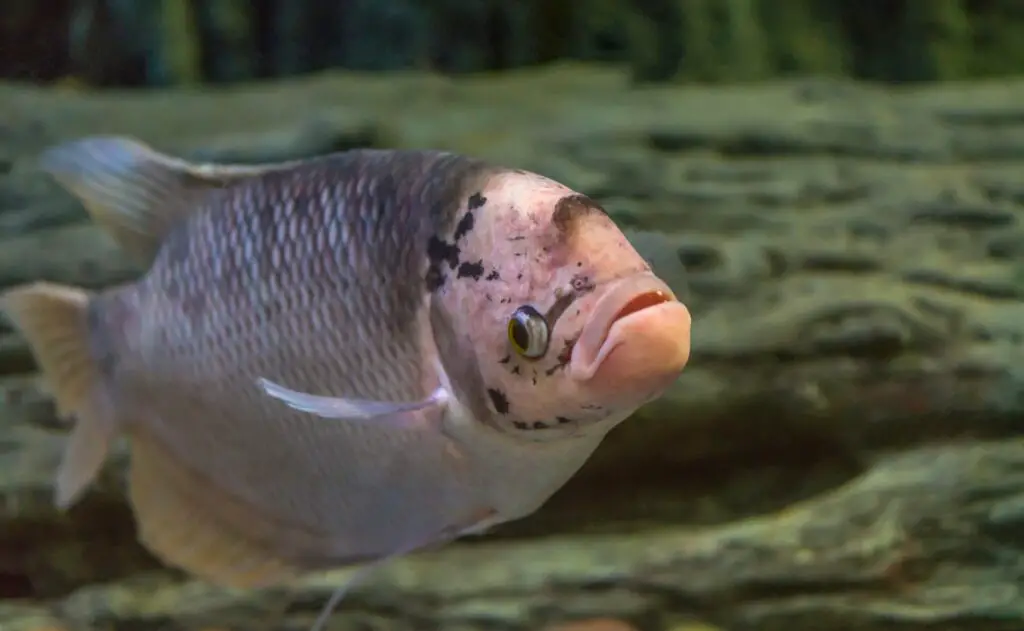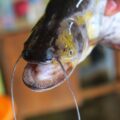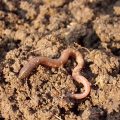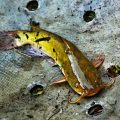Wallagonia Leerii is a species of catfish that is more commonly known by the name “Great Tapah.” This is a unique and interesting species of catfish that anglers love for its size and appearance. This unique fish is found in Southeast Asia, from Thailand to Indonesia.
The appearance of Wallagonia Leerii
You might have heard this fish being referred to as “a “helicopter catfish due to its appearance. Appearance-wise, the fish is almost black in color, with a slightly lighter color in the lower half of its body and has an unassuming body. It has a round and short body with a long, broad tail. Interestingly, the anal fin of the fish is as long as its tail and ends in a forked caudal fin, which gives it a unique appearance compared to other large fishes. The fish also stands out because it has a hump where its dorsal fin is. The fish also has a very large head with sharp teeth lining its mouth, which helps it catch its prey as it is a predatory fish. Also, the lower jaw of the fish is longer than the upper jaw. This is to help the fish catch prey mid-swim easily and scoop fish from the bottom of the ocean.

Size of Wallagonia Leerii
This fish gets remarkably large, making it challenging to catch it. The helicopter fish can grow up to 6 feet and 7 inches in size and weigh 330 lbs. This is why this fish usually occupies the bottom of the ocean to stay hidden. It is not hard to notice once you see it due to its size.
However, it is said that they are smaller they were in the past. Moreover, this is considered a fish that is under threat because of overfishing, competition with invasive species, difficult mating rituals, loss of habitat, and much more. It is still not listed on the list of endangered species, but there are doubts that the fish population is dwindling fast. This also means that it is much more challenging to locate or catch this fish in real life.
Habitat of Wallagonia Leerii
This is a freshwater species that is found in most Asian countries. It is reported that the fish is found in Pakistan, India, Sri Lanka, Nepal, Bangladesh, Myanmar, Thailand, Vietnam, Cambodia, the Malay Peninsula, and Indonesia. It is found in large tanks, rivers, and other water bodies. It usually stays hidden in the grassy, muddy bottom of the water. The fish also hides under holes in canals and riverbanks when it feels under threat. The fish breed during the pre-monsoon summer, and unfortunately, it is hard to distinguish the fish sex as both male and female fish look very similar. During the flooding season, the fish migrate to calmer water, which still needs peaceful water instead of fast-moving water.
Diet of wallagonia Leerii
As mentioned before, this fish is a predator, and a great one at that. This fish attacks and eats fish that fits in its mouth. This usually includes smaller fish, but it can also attack and eat fish that are almost the same size as its body.
The juvenile fish feeds on insects until it gets big enough to eat bigger fish and crustaceans. In fact, in some places like India, it is said that this fish eating pets, livestock, and even humans. Now, this is not 100% proven, but according to research, human body particles have recovered from the fish’s body. This could be due to dead bodies that were pushed into the lake, which gave the fish a taste of human flesh.
Regardless of the truth of this claim, this fish has bitten humans and is capable of doing so. It is a very aggressive fish that will feed on whatever it finds. During feeding time, along with eating the food it is given, it tries to bite the hand that feeds it, so it is very difficult to keep it at home unless the person is very experienced.
Can you keep Wallagonia Leerii at home?
Realistically speaking, it is almost impossible to keep this majestic fish at home. This is due to many reasons like its aggressiveness and the huge tank that it would require. If you want to keep it at home, you will need an outdoor pool or an extremely large custom-made indoor tank. This will cost a lot, and maintenance of the fish also costs a lot. Not to mention, if you want to keep this fish as a pet, it will most likely be shipped from overseas. You would need to check to make sure you can have this fish and it is not illegal to have. Without all these costs, the fish itself is rare, which is why it costs a lot on its own without the additional costs, as well.
When the fish is kept in a pond, you have to keep all pets and young children far away from the pond. This is because the fish is more than capable of jumping out of the tank, attacking whatever it finds on top, and dragging it down into the water. As a whole, this is a fish that is very impractical to keep.
Conclusion
Wallagonia Leerii is a unique catfish and is considered to be the largest among its family. It has a small body and a large mouth, making it a great predator. Also, this fish can get very large. It is found in most Southeast Asian countries and lives in still, very dense water. This fish will eat whatever it finds in front of it, and that could include humans. On the whole, this is a very interesting species of catfish out of hundreds of other species of catfish.











